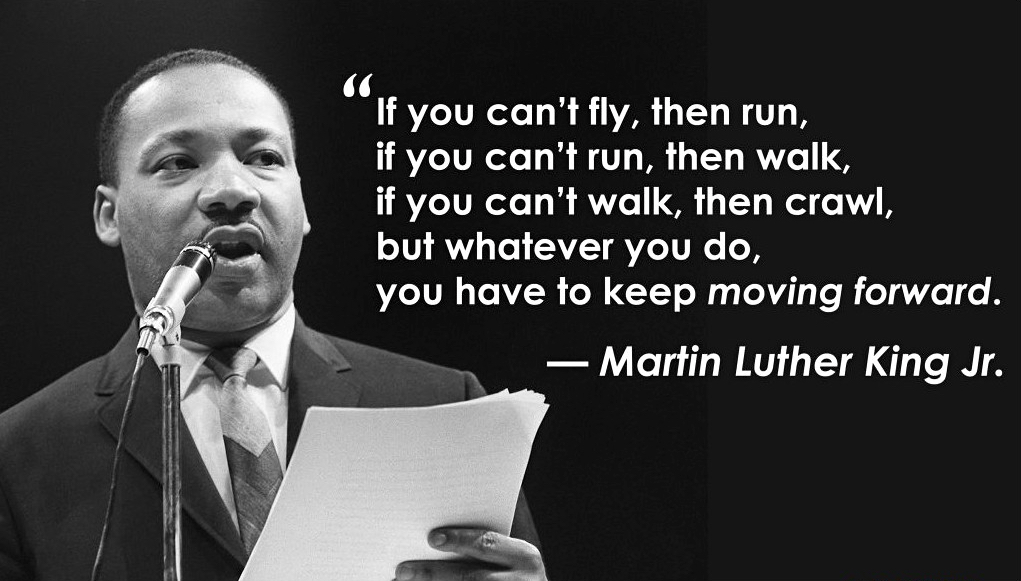It’s MLK Day and the perfect time to start a conversation about how close the knowing-doing gap around improving teaching and learning for diverse students through culturally responsive teaching.
We hear it all the time. We need to get test scores up. We have to improve reading proficiency. Let’s raise math achievement. As educators, we have urgency around these goals but we often lack agency – knowing what we need to do and then doing it, consistently.
That’s why I think on this day that we celebrate the life of Dr. Martin Luther King we should not only remember him as a moral visionary but as a guy who got sh*t done. I know that might seem a bit blasphemous when talking about the good Reverend, but we should remember our history. Despite his nonviolent stance, Martin Luther King was all about disrupting the status quo with action. Not just marching-in-the-streets fist shaking but taking meaningful, strategic action.
He got that from studying the life and work of Ghandi who is attributed with making the now famous statement: You must be the change you wish to see in the world. MLK and other civil rights pioneers knew that it was going to take more than rhetoric to put a dent in segregation.
In the same way, it’s going to take more than rhetoric to fully implement culturally responsive teaching and learning in ways that help students achieve at high levels.
So I wonder how we can think about making changes in our practice in ways that position us to we support culturally and linguistically diverse students in the classroom on a daily basis.
Ghandi says we have to “be the change”. How can we actually “be” that change? Too often we talk about improving teaching and learning as something we do to students, especially those that are struggling. Or we talk about “being the change” from a social justice angle – checking our unconscious biases. Yes, that does need to happen. But I think the knowing-doing gap persists because we don’t position ourselves to know how to change the way we deliver instruction. The first order of business: Stop looking for a set of “plug and play” strategies that are supposed to magically transform struggling diverse learners into high achievers.
Instead, be like MLK and roll up your sleeves to make concrete changes to your teaching moves so kids know how to change their learning moves.
To set the stage, here three steps that will position you to do just that.
Identify your circle of influence. Too often we talk about what’s not working across our school or we just wring our hands over low achievement data. Steve Covey, author of The Seven Habits of Highly Successful People says that instead of being overwhelmed by the big picture that you have no influence over any way, start closer to home.
In this case, start in your own classroom. Stop asking for permission to improve your practice. MLK didn’t ask for permission to dismantle segregation. He started small in his own church and community. His success there grew his influence until it spread around the world.
Identify small but significant changes to make. Sometimes the challenges in front of us seem so big, so overwhelming, and have gone on for so long that change seems impossible. In that case, we have to “shrink the change”. Find one small high-leverage thing that you can change that would be a catalyst for other positive changes. (Remember, not every change is high leverage). In culturally responsive teaching, there are two areas worth our attention: creating counter narratives to help cultivate students’ academic mindset and improving information processing in our lesson planning. What are you doing in either of these areas that is getting the results you want? If current practices aren’t yielding the desired results for students, it’s time for a change.
Strategize about how to make this new way of teaching a habit over time. Culturally responsive teaching is more than a set of multicultural “best practices,” strategies or activities. Instead it is a way of teaching so that the learner builds on those neural pathways associated with the way he learns at home. Do you know what those are? Then put learning them on your personal PD agenda.
These three steps position each of us to start closing the knowing and doing gap when it comes to culturally responsive teaching. Remember the old adage: If you change nothing, nothing changes. Don’t know what to change? Add that to the personal learning plan.
In the coming weeks, I want to dig into this conversation some more. In the meantime, tell me how you are “being the change” not just in terms of your relationship with diverse students in your classroom but in helping them improve their learning. What needs to change in your teaching practice so that they become more independent learners?
Come join me on Instagram and continue the conversation.
Happy MLK Day #ReclaimMLK


